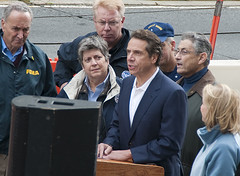
Bill Daniels getting chicken feed from the feed bags which he must store in one of his three rooms. Panther Red Ash… – NARA – 540999 (Photo credit: Wikipedia)
The New Year ushered in new legislation in many states, including some “green laws” that we find worthy of comment today.
The state of Maryland enacted a new law that prohibits the use of chicken feed that contains arsenic, a known carcinogen. This is the first law of its kind in this nation, which bans the use of arsenic-containing additives, specifically roxarsone, in chicken feed. The bill to prohibit arsenic-containing chemicals in chicken feed was sponsored by Del. Tom Hucker (D-Dist 20) of Silver Spring. Del. Hucker notes that this new law is “a win for all Marylanders.” Historically, arsenic-containing additives were added to chicken feed to protect the birds from parasites. However, this chemical can build up in the birds’ bodies and manure and then can be washed into the Chesapeake Bay. it is important to note that arsenic has been linked with diabetes, heart disease and cancer. This win comes with a caveat as the poultry industry expresses concern that roxarsone (previously manufactured by Pfizer and voluntarily suspended in 2011) could be marketed again as a similar product by a different company. It is important that we watch for any new developments that may occur in response to this new legislation.
A second piece of legislation worthy of mention is New York’s new law that exempts the sale and installation of commercial solar energy system equipment from state sales use tax. This law was enacted in response to the state’s commitment to “achieve the goal of 45 percent of New York State’s electricity needs through clean renewable energy and improved energy efficiency by 2015.” Sen. George Maziarz (R-C, Newfane) Chairman of the Senate Committee on Energy and Telecommunications, notes that eliminating all state sales tax on solar systems equipment and installations and providing local municipalities the option to do the same should serve to stimulate the economy with increased commercial solar installations and the creation of more jobs to complete the work. This law definitely should serve as a model for other states to increase the use of clean renewable energy while simultaneously stimulating the job market.
Our third selection of legislation to discuss can be found in the state of Iowa, which enacted a new law that allows the Department of Natural Resources (DNR) to permit anglers to fish with three poles and a total of six hooks for an additional $12 licensing fee. This law is aimed to spur ice fishing which is trying to rebound after a poor showing last winter. Additionally, the Iowa DNR passed a new law that makes licensing more convenient by permitting hunting and fishing on a combined license. The goal of these laws are to promote more outside activity, which definitely is green.
There are so many things we can do to protect the environment and promote healthy living. Today we at LGBG salute the states of Maryland, New York and Iowa for the steps they have taken to protect the environment and to help us all live green, be green.
Sources for this article:
http://www.gazette.net/article/20121231/NEWS/712319987/1122/bethesda/New-Maryland-laws-target-veterans’-licenses-chicken-feed-elections&template=gazette
http://bellmore.patch.com/groups/politics-and-elections/p/laws-taking-effect-on-jan-1-2013#




